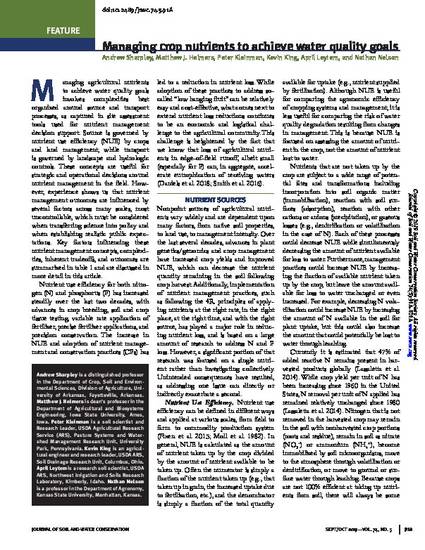
Landscapes and watersheds are inherently leaky and some nutrient loss can be expected with productive agricultural systems. Minimizing these losses, without undermining system sustainability is challenging and should involve an open and constructive discussion among all stakeholders as to what nutrient loss is desired, achievable, and how differences between these two endpoints can be reconciled. This is complicated by short- and long-term variations in weather/climate are a major factor influencing nutrient loss from agricultural lands. Nitrogen (N) loss tends to be spatially extensive, with management of the rate and timing of application, along with cropping systems as being important determining factors. Phosphorus (P) loss, on the other hand tends to be a function of critical sources areas, where coincident source (e.g., soil P and rate, timing, method and type of P applied) and transport factors (e.g., runoff and erosion) define losses. Despite this, legacy N and P from prior land management can mask the benefits of current and future conservation practices (CPs) to reduce losses from agricultural systems. Here, the appropriate use of calibrated and validated nonpoint source watershed models to estimate relative contributions of nutrient sources and outcomes of CP implementation can inform future strategies. However, they must be used in conjunction with and cannot replace water quality monitoring programs. Great strides have been made in nutrient use efficiency via nutrient management, crop selection, and CP adoption, which have reduced the risk of nutrient loss to surface and ground waters. Even so, additional research is needed on the areas of nutrient management on drained lands, fluvial legacies, and socio-economic factors influencing the success of conservation strategies.
Available at: http://works.bepress.com/matthew_helmers/229/

The following article is published as Sharpley, Andrew, Matthew J. Helmers, Peter Kleinman, Kevin King, April Leytem, and Nathan Nelson. "Managing crop nutrients to achieve water quality goals." Journal of Soil and Water Conservation 74, no. 5 (2019): 91A-101A. Posted with permission.
Works produced by employees of the U.S. Government as part of their official duties are not copyrighted within the U.S. The content of this document is not copyrighted.